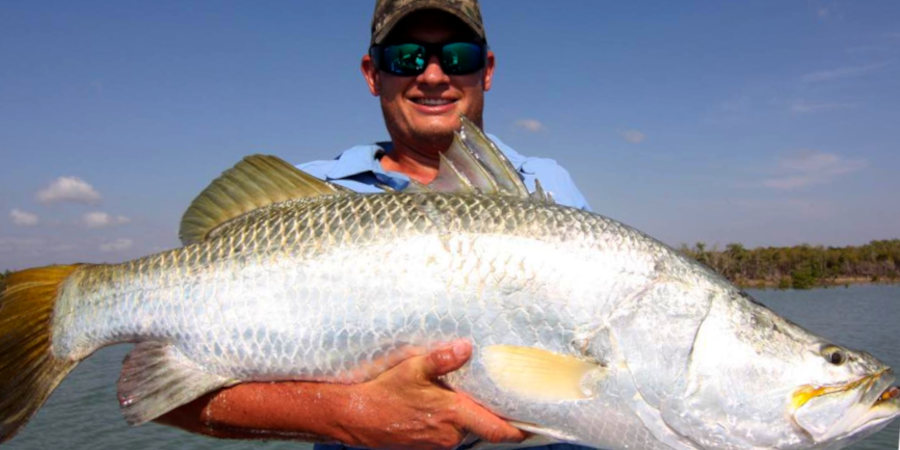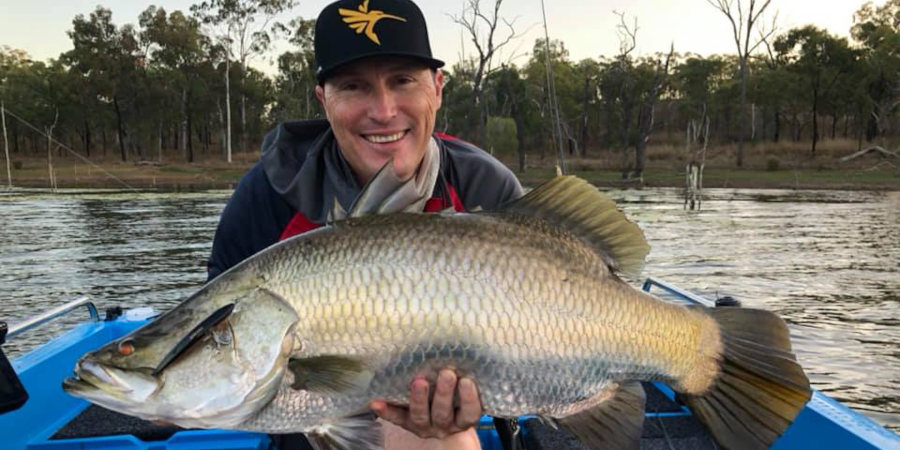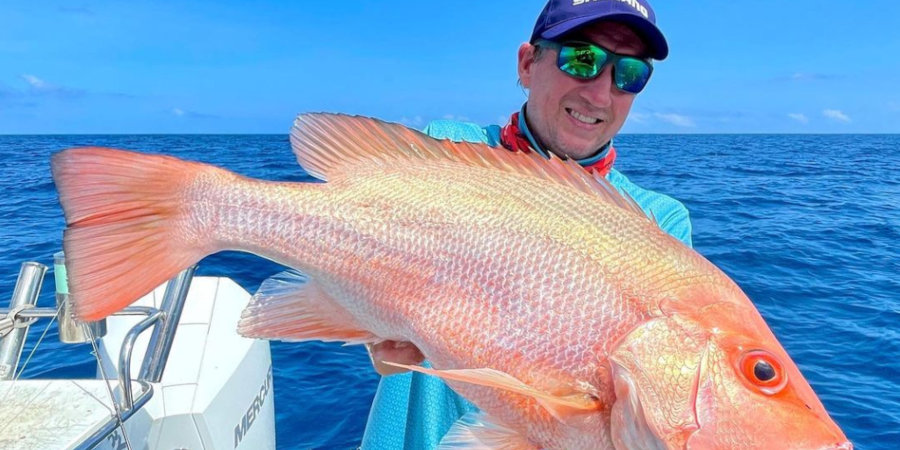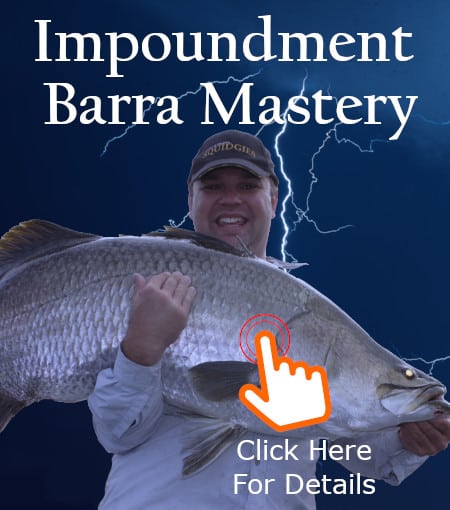
Greeny’s Vibing Tactics For Barra
- Soft vibing is often the best way to tempt barramundi when they’re sticking close to the bottom in relatively snag-free water. The big advantage of vibes is that they can be fished both vertically and horizontally and by virtue of their vibration will attract a lot of fish. The biggest disadvantage of vibes is that they are very snag-prone.
- Most vibes work reasonably well but the best ones sink quickly, whilst still fluttering on the drop. This allows the angler to get the lure down to the barra in a current but also results in more strikes since barra frequently take vibes with this trait as they’re sinking. The other qualities to look for are vibes that have a strong, fast vibration on the lift, even when lifted very slowly, keeping them working in the strike zone for longer. The Zerek Fish Trap is one of Greeny’s favourites.
- Cheap vibes can work but often the rear hook connection isn’t strong enough to handle barramundi, resulting in a lost fish and destroyed lure.
- 95-100mm size vibes are usually the most effective on barra. Sometimes larger ones can be effective if the current is strong and/or the bait are large.
- Sidescan sonar can be very beneficial – spend some time looking for “runways” or “corridors” that are like a cricket pitch running up between the snags. These areas allow the angler to work a vibe close to the bottom between structure and fish will often move along these corridors. Barra will also take a vibe often the bottom in these runways, so it doesn’t hurt to let the lure sit on the bottom for 4-5 seconds between hops. Again, Greeny likes the Zerek Fish Traps for this, as the curly tail maintains micro-movement when the lure is stationary.
- Alternatively, vibes can be worked vertically through timber. With practice you’ll get the feel for dropping the lure through vertical structure and working it back up effectively.
- In addition to spending time planning where to cast, also think about where the fish is likely to run to once hooked and have a plan to extract it. It’s sometimes necessary to be quite brutal when vibing barra in corridors.
- It’s not just the corridors that fish well using vibes, running soft vibes parallel to weedbeds can also be very effective. And some of Australia’s top tournament anglers have enjoyed massive success fishing vibes vertically to barra mooching in deeper water. In systems like the Fitzroy where barra and threadfin tend to school and feed over fairly clean sand and mud, or around rockbars, the vibe is a great tool for searching and covering a lot of water.
- Greeny finds it’s important to have the rod in your dominant hand when vibing as it’s very important to have very sharp reaction times. It’s also important to be standing and have the right posture and that you never take your eye off the line. Barra nearly always hit a soft vibe on the drop and can inhale and eject it in a fraction of a second – reacting fast to the slightest “tick” on the line is the key. They rarely hook themselves.
- Greeny likes spin gear for vibing because the weight of the reel is beneath the rod and tends to balance the outfit better for striking a fish while the lure is dropping. Small reels are fine and good quality reels tend to have excellent drag pressure for their size. David has 2500 and 3000 size Shimano Stella’s and Daiwa Certates that are 10 years old and still working very well. Single handed spin rods with a butt length of around 30cm and balanced so that the rod is horizontal when held just in front of the reel are perfect. 10-15 kg braid is perfect, Greeny doesn’t have a preference for braid, but Suffix works fine. He attaches about 1.5m of 50lb Black Magic fluorocarbon leader with an FG knot and attaches his lure with a loop knot. Be prepared to re-tie your leader after every fish – and also be prepared to switch down to 40 or even 30 lb leader if the water is clear and you need to do so to get the bite.
- A medium to medium-fast action rod is the best option as it has enough softness in the tip that it will allow the lure to drop back a little more when the fish takes it, increasing the chances of a hook set.
- When hopping the vibe through corridors the rod lifts are usually just between 8 and 10 o’clock, lifting the lure 20cm or so at a time – the bigger fish tend to be close to the bottom, so keeping the lure in their face is key. Sometimes the fish will come a bit higher up the water column and the lifts can be increased to suit that scenario.
- Between hops the lure needs to sink on a completely slack line to enable the fish to inhale it properly, having tension on the line will result in missed bites. Watch the braid like a hawk though and be prepared to strike at the slightest sign of a bite. This can be difficult when working the lure against a current, you’ll need to constantly release a little line to allow the lure to freefall. Greeny has even been known to disable the anti-reverse on his spin reel to facilitate this – a dangerous tactic that takes practice to perfect.
- Greeny finds that vibes are a good lure to carry scent and uses the Sax Scent Gold Prawn, which he’s found effective in dams especially. He’s not sold on the value of scents but will use them if they’re on hand.
- The bite windows on barra can be ridiculously short at times, especially in food rich environments like dams. In rivers and estuaries the bite windows tend to be a little longer and can be stimulated more by tide changes and water level rises. Modern electronics are fantastic and allow the angler to find and see fish, but can lead to spending a lot of time sitting on a school of inactive fish. Vibes can be helpful because they can be kept in the zone for longer and twitched in the fish’s face. The fish you want to see are moving fish and rising fish – they usually only come up off the bottom to feed.
- Barra suck vibes in deep and then spit them out lightning fast, so having hooks that are more likely to find their mark is important. Greeny likes the recurved Decoy hooks because they’re harder for fish to spit out and seem to work very well with vibes.
David “Greeny” Green
Fishing Journo and Tournament Angler
Greeny is a well-known Aussie fishing identity and prolific fishing writer. Although he’s Gold Coast based, he regularly makes the trek to the north to compete in barra tournaments, such as the barra nationals where he’ll be competing when this episode goes to air.
Related Episodes

Victoria and Roper Rivers Barramundi With Trent De With
ALF EPISODE 681 Fishing for barramundi in the Victoria and Roper rivers is an experience every angler should aspire to. With unique challenges and rewarding catches, these rivers in the Northern Territory are prime spots for landing this iconic species....

Barramundi Fishing In Lakes Awoonga And Monduran: A Comprehensive Guide
Get all the advice you need for fishing Lake Awoonga and Lake Monduran. Gun angler and former guide Roderick Walmsley shares his tips here.

Central Queensland Barra Lakes With Roderick Walmsley
Rod's interview on barra lakes was ALF EPISODE 648. Check out our lure fishing archives for more information on Barramundi Fishing, or grab our guide to Barramundi Lures. Roderick Walmsley Fishing Writer and Personality Roderick has made a life out of fishing. A...

Barramundi Paradise: Lakefield National Park Fishing
Lakefield National Park is a remote barramundi wonderland, but Luke Galea reckons it’ worth “doing the miles to get the smiles” even when you’re off the beaten track already. Tune in as he explains how to plan and execute a land-based Lakefield National Park fishing odyssey.

Unravelling Trophy Wet Tropics Barramundi In The Spring
ALF EPISODE 637: This Interview With Brodie Quaas Is His Second On Wet Tropics Barramundi. You Can Check Out His Previous Episode Here. Or, Get Our Barramundi Lures Guide Brodie Quaas Far North Queensland Fishing Guide Brodie is a former NSW tournament angler who...

Five Groote Eylandt Fishing Adventures With Bomber Farrell
Bomber Farrell returns to the ALF podcast, this time to explain his top five Groote Eylandt fishing experiences!

Victoria and Roper Rivers Barramundi With Trent De With
ALF EPISODE 681 Fishing for barramundi in the Victoria and Roper rivers is an experience every angler should aspire to. With unique challenges and rewarding catches, these rivers in the Northern Territory are prime spots for landing this iconic species....

Barramundi Fishing In Lakes Awoonga And Monduran: A Comprehensive Guide
Get all the advice you need for fishing Lake Awoonga and Lake Monduran. Gun angler and former guide Roderick Walmsley shares his tips here.



0 Comments